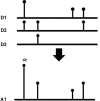Identification and analysis of mutational hotspots in oncogenes and tumour suppressors
- PMID: 28423505
- PMCID: PMC5400584
- DOI: 10.18632/oncotarget.15514
Identification and analysis of mutational hotspots in oncogenes and tumour suppressors
Abstract
Background: The key to interpreting the contribution of a disease-associated mutation in the development and progression of cancer is an understanding of the consequences of that mutation both on the function of the affected protein and on the pathways in which that protein is involved. Protein domains encapsulate function and position-specific domain based analysis of mutations have been shown to help elucidate their phenotypes.
Results: In this paper we examine the domain biases in oncogenes and tumour suppressors, and find that their domain compositions substantially differ. Using data from over 30 different cancers from whole-exome sequencing cancer genomic projects we mapped over one million mutations to their respective Pfam domains to identify which domains are enriched in any of three different classes of mutation; missense, indels or truncations. Next, we identified the mutational hotspots within domain families by mapping small mutations to equivalent positions in multiple sequence alignments of protein domainsWe find that gain of function mutations from oncogenes and loss of function mutations from tumour suppressors are normally found in different domain families and when observed in the same domain families, hotspot mutations are located at different positions within the multiple sequence alignment of the domain.
Conclusions: By considering hotspots in tumour suppressors and oncogenes independently, we find that there are different specific positions within domain families that are particularly suited to accommodate either a loss or a gain of function mutation. The position is also dependent on the class of mutation.We find rare mutations co-located with well-known functional mutation hotspots, in members of homologous domain superfamilies, and we detect novel mutation hotspots in domain families previously unconnected with cancer. The results of this analysis can be accessed through the MOKCa database (http://strubiol.icr.ac.uk/extra/MOKCa).
Keywords: cancer; mutation; oncogene; tumour suppressor.
Conflict of interest statement
None.
Figures





References
-
- Baeissa HM, Benstead-Hume G, Richardson CJ, Pearl FM. Mutational patterns in oncogenes and tumour suppressors. Biochem Soc Trans. 2016;44:925–31. - PubMed
MeSH terms
LinkOut - more resources
Full Text Sources
Other Literature Sources

